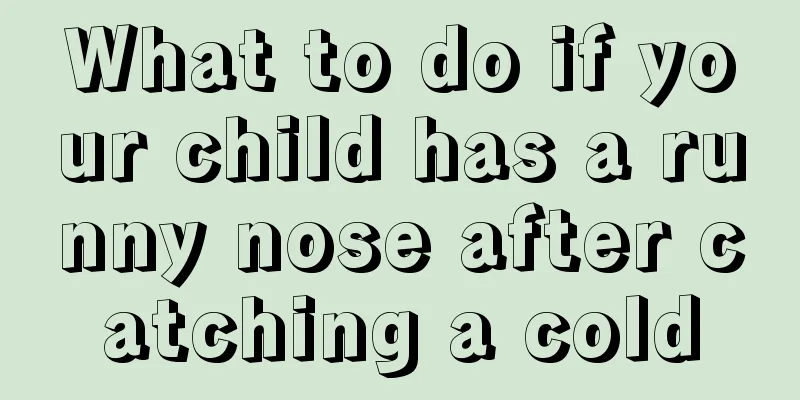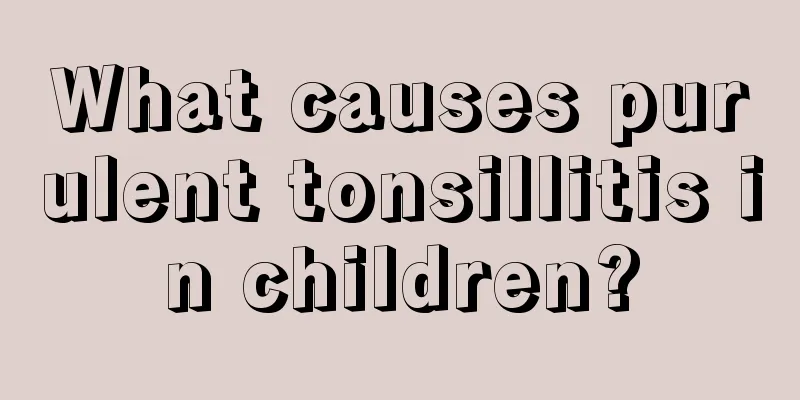What to do if your child has a runny nose after catching a cold

|
Children's bodies are in a period of rapid growth and development, but their immunity is particularly low. They are particularly prone to catching colds when the seasons change. However, many parents will find that their children have a runny nose after a cold, and frequent wiping of the nose can easily cause the nose to be scratched, which will also cause more pain to the child. If not treated in time, it will have a great impact on the child's health and may even cause nasal congestion, which will also affect the child's sleep quality. Therefore, it is necessary to master certain methods to make adjustments. Let's learn about what to do if a child has a runny nose after a cold. What to do if your child has a runny nose after catching a cold The nasal mucosa of children has more blood vessels than that of adults, and the secretions are more. In addition, the nervous system's regulatory function on nasal mucosal secretion and ciliary movement is not yet fully developed, and children are not good at wiping their noses by themselves, so they often have clear nasal discharge. This is a normal physiological phenomenon and there is no need to worry. If there are two lines of snot hanging under the child's nostrils all day long or yellow-green purulent snot flows out, it is a sign of illness. People who have yellow-green, purulent nasal discharge for a long time may suffer from sinusitis. Frequent runny nose may be caused by a lack of vitamin A and vitamin B, and treatment with these two vitamins can be effective. Allergies to inhaled dust can cause a large amount of clear nasal discharge within a short period of time. A small number of children with foreign objects in their nasal cavity may also have a runny nose frequently. Some children with nasopharyngeal lymphadenopathy also often have a runny nose, but they also have symptoms such as severe snoring, dull facial expression, and a flat nose, which can seriously affect their development and posture and should be treated in a timely manner. In short, children with runny nose should be treated accordingly according to the cause. Strengthening cold-resistance exercises, letting children go outdoors more often, keeping the air fresh, and proper nutrition can all help prevent runny noses in children. Diet therapy for children's cold: 1. Grind 30 grams of mung beans, put 10 grams of tea leaves into a cloth bag, add a large bowl of water, boil until half a bowl of water remains, remove the tea bag, and add appropriate amount of brown sugar. It has the effect of clearing away heat and relieving exterior symptoms. 2. Add 50 grams each of Amaranthus and Honeysuckle and 10 grams of licorice to a large bowl of water, decoct and take 3 to 4 times a day. It is used to treat wind-heat colds such as fever, chest tightness, dizziness, fatigue, and short and red urine. 3. Take 15 grams each of garlic and ginger, cut them into slices, add a bowl of water, boil until half a bowl remains, and take it all at once before going to bed. Add appropriate amount of brown sugar when taking it to treat colds. 4. Wash and chop 60 grams of scallion, add three cups of water and boil it until it becomes two cups. Drink one cup while it is hot, then heat it up after half an hour and drink another cup. It can cure wind-cold colds such as aversion to wind, fever, and cold nose. 5. Boil a radish and 6 to 7 green olives in water and drink it instead of tea. Specially used to treat dry mouth and nose, fever, runny nose, sore throat, thirst and colds. 6. Take appropriate amount of scallion, cut it into thin strips, soak it in boiling water, and fumigate your mouth and nose while it is still hot. Specially used to treat colds and nasal congestion in infants. The above is an introduction to what to do if your child has a runny nose after catching a cold. When such symptoms occur, parents must pay attention to it. First, go to the hospital to treat the cold. If the runny nose still exists after the cold is recovered, timely adjustments must be made. Eat light food, drink more boiled water, and take your children outdoors for exercise more often to improve the body's immunity. |
<<: What to do if your baby has a fever and blushes
>>: What to do if your baby coughs in spring
Recommend
What should I do if my baby's fontanelle is closed?
The baby's body is very fragile, so once ther...
Reasons why babies bite their nails
In fact, in daily life, many people do not have t...
How to protect children's teeth with white spots
We need to eat a little when we eat, and we also ...
Treatment for babies who are easily startled when sleeping
Many people's children, especially newborn ba...
What causes vomiting in young children?
Many parents have encountered vomiting in their y...
Do five-year-old children need to have their cavities filled?
In recent years, the phenomenon of babies sufferi...
What to do if your child has a hoarse throat due to internal heat
Getting angry is a problem that many people have,...
What should I do if my child has stomachache?
Our modern lives are becoming more and more afflu...
How to improve children's self-confidence
We will find that children with self-confidence a...
Dosage of Spectramycin Injection for Children
Azithromycin injection is a medicine for treating...
What should children drink if they are allergic to milk powder?
It is impossible for babies to always eat breast ...
What to do if the child has internal heat?
The most obvious manifestations of damp-heat in c...
Symptoms of baby allergy to egg white
Some babies have allergic constitutions, and eati...
What are the developmental indicators of a 25-month-old baby?
Nowadays, every family has one child, which makes...
How to deal with a child's high fever convulsion
High fever and convulsions in children are quite ...









